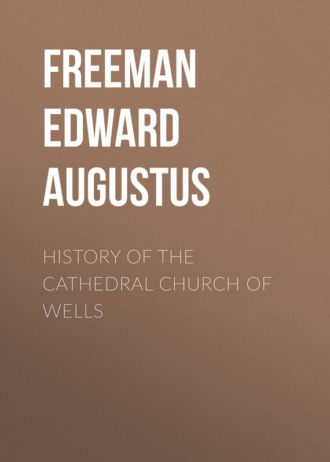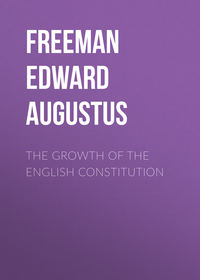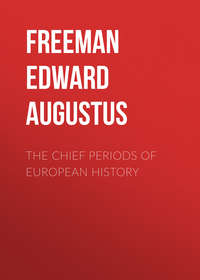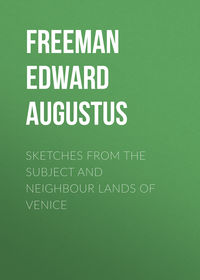 полная версия
полная версияHistory of the Cathedral Church of Wells
Still, when I speak of the work as being the work of Jocelin, I ought perhaps to pause and explain, and in some sort to qualify, my meaning. As regards the design of the building, Jocelin may or may not have been his own architect. In some of our great churches there is no doubt that the Bishop, the Abbot, or some other member of the society, really was the architect. William of Wykeham, long after Jocelin's time, really designed his own nave at Winchester, but we read of some of the works in Saint Alban's Abbey that they were designed by one of the other officers of the monastery, but that it was held right to attribute them to the Abbot, on account of his higher dignity.81 While Jocelin's nave was building, the vault over the nave of Gloucester Abbey was actually made by the hands of the monks themselves.82 In other cases there can be no doubt that professional architects and masons were employed, just as they are now.83 The vault which fell in at Wells was being made, not by the hands of the Canons or of their Vicars, but by those of skilled workmen. One thing is certain, that the designer of the local work at Wells must have been a local man; whether he was actually Jocelin of Wells in his own person I cannot say. Another thing is equally certain, that, before the work was done, the local style was forsaken and another style was adopted in its stead. And that this was the personal act of Jocelin is shown by the new style being used, not only in the west front of the church, but in his own domestic buildings both at Wells and at Wookey. And as to another point, when I call the work Jocelin's work, I do not necessarily mean that he paid out of his own pocket for everything that was done. We must remember that in Jocelin's day we are just at a moment of transition in the history of our own and of other churches. The earlier Bishops, who did what they pleased, no doubt paid for whatever they did. At any rate, we cannot suppose that the Canons of Wells in the eleventh century did, out of their poverty and beggarly estate, contribute much either towards the erection of Gisa's buildings or towards their pulling down by John of Tours. In our own day, as we all know, any works done to the cathedral are done by the Chapter, either out of their own funds, or out of funds collected by them. In the intermediate ages we sometimes find works of this sort attributed to the Bishop alone, sometimes to the Chapter alone, sometimes to the Bishop and Chapter working together. I suspect that this last would commonly be the truer account in all cases; at any rate, what either Bishop or Chapter did the other party must have consented to. Jocelin was doubtless the great mover in the work, the life and soul of the whole undertaking. The whole would be done under his care, and his personal contributions would doubtless be large. But all this in no way shuts out the co-operation of the Chapter, of the clergy and laity of the diocese, and of well-disposed persons wherever they might be found.84
Another part of the buildings of the church belongs to the age of Jocelin, where his hand might not have been looked for at first. This is the cloister as it stood in its first estate. You will remember that the cloister which was built by Gisa, together with his dormitory and refectory, was pulled down by John of Tours. You will also remember that a cloister, which in a monastery is an essential part of the building, and is always built after a particular model, is in a secular church a mere convenience, which may perfectly well be left out, and which may be built in any place and after any fashion which may be thought good. Jocelin then, or his Canons, now built them a cloister, but it was a cloister which was no longer accompanied, as in Gisa's time, by any refectory or dormitory. It is more like a monastic cloister than those of Chichester and Hereford; it is less like one than that of Salisbury. It occupies, like a monastic cloister, one side of the nave; still it is not a perfect square, but an irregular parallelogram; it has no walk on the north side, and the eastern walk comes up against the south end of the transept, while in a monastery it would have been built against its western wall. To the east, where the chapter-house would have stood in a monastery, there was a detached Lady chapel, of which the traces may easily be seen, but which was rebuilt late in the fifteenth century and wholly destroyed in the sixteenth. Now that the cloister was first built at this time is plain, as all the outer walls, including that very pretty doorway leading to the Palace, are all of Jocelin's date. The doorway leading from the transept into the cloister is also mentioned in an Act of Chapter in 1297, printed in Dugdale's Monasticon.85 But this very doorway, and the doorway which is in some sort the fellow to it in the south-western tower, give us the surest signs that the cloister is not now in the same state in which it was originally designed. Even in its first estate, it seems to have been, as we should expect, an addition, though an addition made not very long after the building of the part of the church which it joins. The wall comes up uncomfortably close against this fine doorway, though it does not mutilate it in the way which is done by the vault which was added long after. This vault, and the window-tracery of the cloister of the same date, are therefore not only later additions, but additions which could not have been so much as contemplated when the cloister was first built. What then was the cloister in its original state? That its outer wall was of stone is plain; but I believe that whatever was inside, the roof and whatever there may have been in the way of tracery or arcading, was of wood. Wooden cloisters were not uncommon. Even in so great a monastery as Glastonbury, it is plain that the cloister was not of stone.
Jocelin, the great builder of the fabric, is hardly less memorable with regard to the constitution of the church. He put the last touches to the system which had been devised by Robert. To him, as we have seen, was perhaps owing the foundation of the other dignities besides the two chief ones, the Deanery and the Precentorship. He certainly increased the number of prebends, and enlarged or settled again the endowments of some of them.86 And to him is owing the beginning of another class among the officers of our church, who still remain among us; I mean the Vicars. The institution of this order is closely connected with certain changes which were going on about this time in our own and in other capitular bodies, and which produced the distinction which I have already mentioned, and with which we are all familiar, between Residentiary and Non-residentiary Canons. All the old capitular bodies were framed upon one general model, the essential features of which they retain to this day. But, amid this general likeness, each church has its own personal peculiarities; it would be impossible to find two Old Foundation cathedrals in England which are exactly alike in the names, numbers, and duties of their officers. And so with the change of which I am now about to speak; it happened in all the secular cathedrals with the single exception of Llandaff; but it was not brought about in all by exactly the same stages nor at exactly the same time. The general result was the same in all; but the process was not everywhere the same, and this or that change might be made a few years earlier in one place and a few years later in another. The exact dates and stages in the church of Wells I am not prepared to tell you, till all the information which now lurks in manuscript has been unlocked by means of the printing-press. There is one among us who has no doubt mastered every single record in its existing form, and who, I feel sure, can tell us the year, day, and hour of every change of detail. But all I can do is to point out the stages of change in a general way, and to mark that in the time of Jocelin the changes of which I speak were at least beginning.
I have already spoken of that inveterate tendency to pluralities, and consequently to non-residence, which was the bane of the mediæval Church, and which brought to nothing so many fair schemes of discipline and reform. This had already begun to extend itself to cathedral foundations. We may be sure that in early times the whole body of Canons were constantly resident. Gisa at all events, we may be sure, would allow of no absentees from the common refectory and the common dormitory. But the changes made by Robert would certainly tend to make non-residence possible. A Canon was no longer a mere member of a body which, even as a body, had hardly any corporate rights. His prebend had now been made a distinct benefice, as independent, as far as its temporal possessions went, as a Bishoprick or a rectory. The feudal ideas which, as I before said, came to be applied to ecclesiastical benefices, would come to be applied to a prebend no less than to a Bishoprick or a rectory. It would come to be looked on as a benefice, which a man might, as in the case of any other benefice, hold along with any other preferment, and, as in the case of any other benefice, its holder would deem his conscience discharged if its duties were discharged by deputy. The non-residence of Canons became a matter of complaint in the twelfth century. It was a favourite subject for monkish writers, who naturally found in it a fruitful field for declamation against their secular rivals. Thus Richard of Devizes, one of the most amusing writers of that or of any age, holds forth on the superiority of the monks who praised God with their own mouths, while the Canons praised Him only through the mouths of their Vicars. He goes on to draw a grotesque picture of a stranger coming to ask alms at the door of a rich Canon. The door is opened by a poor Vicar, who bids the wayfaring man go away, as the master of the house is not at home.87 Then, at a somewhat earlier time, in the Life of Saint Thomas of Canterbury, we find how the man whom he sent over with a bull of excommunication against the Bishop of London went to high mass in Saint Paul's Cathedral on so great a festival as the Ascension, and found the officiating priest to be neither Bishop, Dean, nor Canon, but only a Vicar.88 An incidental notice of this sort speaks volumes.
The non-residence of the Canons was in itself an evil, and it grew out of a relaxation of discipline; still it wrought some incidental good by calling into being a class of men whom I look upon as highly valuable, and indeed as essential to the proper working of the cathedral system. I mean the Non-residentiary Canons. The distinction between Residentiary and Non-residentiary Canons, which is found in all the strictly English cathedrals of the Old Foundation, grew up in different churches at nearly the same time and by nearly the same steps, but with some differences of detail in each case. The first stage seems to have been one of very general non-residence. The Canons lived at the cathedral or not just as they pleased; those who did not reside keeping (as we have incidentally heard) Vicars to discharge their share of the duties of the church. Here we have the origin of that body of Vicars, clerical and lay, whom we still see among us. The Vicar at first was simply the deputy of the Canon whose place he took, just as a curate takes the place of a non-resident rector. Each Vicar was thus dependent on a particular Canon, who was looked upon as his Master. Of this name, after the lapse of so many ages and after such great changes in the position of the Vicars, we still have traces among us. Among the legislative acts of Jocelin were some which concerned the institution of Vicars.89 He certainly did not form them into a corporation, which was the work of a benefactor of the next age. But he probably insisted that the non-residence of the Canons should not involve any neglect of the services of the church, that every absent Canon should be represented by a competent Vicar, perhaps even that each Vicar should receive a decent stipend. It is plain that the principle of non-residence was already recognized. Savaric, in founding two new prebends in the church, had directed them to be held by the Abbots of Muchelney and Athelney for the time being.90 It probably was good policy thus to connect the heads of two great monastic houses in the diocese with the diocesan church. But it is plain that the two Abbots were not meant to reside permanently at Wells. They would have their votes in Chapter, and they would come to give them on fitting occasions; but their share in the ordinary duties of the cathedral must have been discharged by deputy from the beginning.
Non-residence thus became rife everywhere. But strict men naturally looked upon it as a scandal. It was not fitting that all or most of the responsible officers of the church should be habitually absent from their post, leaving their duties to be discharged by deputy. And it is likely enough that the deputies might not in every case be the most creditable representatives of their principals that could be found. It was needful to take some steps to check the system by which, in cathedral churches as well as elsewhere, one man did the work while another took the pay. On the other hand, we can see a growing and very reasonable feeling that, as it was not possible, so neither was it desirable, to demand constant residence at the cathedral from the whole of so large a body as the Canons had now become. Now that the prebends had been increased to so great a number as fifty, there was really no object in requiring the holders of all of them to be always present either in the choir or in the chapter-house. The twofold objects of the cathedral foundation would be better carried out by dividing the Canons into two classes. One portion of the body was placed constantly on the spot, to maintain the regular services and to discharge the routine duties of the corporation. Another portion consisted of men scattered about the diocese, appearing at the cathedral only at stated seasons, who, as being at once cathedral clergy and diocesan clergy, might help, above all other men, to keep up the connexion between the mother church and the diocese at large. How far these objects were consciously present to the minds of those who established the distinction between Residentiary and Non-residentiary Canons, I do not pretend to say; but I do say that the distinction has really worked for good, and has given us, in the Non-residentiary Canons, a very valuable body of men, whose position I should like to see better appreciated than it commonly is. This is, however, a subject which will again come before us, and at present we have to deal only with the origin of the distinction. In the first stage no fixed number of Residentiaries was appointed. It was open to every Canon to reside if he chose; and if he chose to reside, he was in every sense a Residentiary. There could not be then, as there is now, the strange sight of Canons, even dignitaries, of the cathedral, who really do reside, but who are not reckoned as Residentiaries, while others bear the name of Residentiaries who come among us for three months in the year only. The first stage was commonly this. Every Canon could reside or not, as he pleased; but those who did reside enjoyed great worldly advantages over those who did not. The common revenues of the corporation were divided among those only who resided, while those who did not reside received only, what the corporation of course could not meddle with, the incomes of their own prebends. The non-resident thus had only his prebend; the resident had his prebend and a share in the common income as well. This is all explained in a statute of Jocelin himself, dated in 1242, the year of his death, in which a daily distribution is ordered to such Canons and Vicars as are present, while at the end of the year the remainder of the common revenues is to be divided among such Canons as have kept residence. Residence is defined to be six months in the year for a simple Canon, that is, for one not a dignitary, and eight for the Dean, Precentor, Chancellor, and Treasurer.91
With this stage, when residence was voluntary, is connected the curious institution of ribs, which, as far as I know, is peculiar to our own church. A rib, as many of you know, is a house, or a piece of ground fit for building a house, which the Bishop must give to some Canon, but which he might give to any Canon that he pleased. If therefore the Bishop wished to call into residence any Canon who had not a house of his own, he might give him the means of residing by giving him a rib. At this stage, then, residence was optional, just as it is at this moment among Fellows of Colleges in the Universities. But there was this important difference, that the resident Canon, unlike the resident Fellow, greatly bettered his income by residing. The natural result was that, whereas hitherto the tendency had been to shirk residence, there now was a general rush of the Canons to reside. And this new tendency to residence next led to all kinds of devices to hinder residence. If a small number were already residing, and therefore divided the common fund among them, they would be tempted to look with no friendly eye on those of their brethren who came trooping in to share their funds, and thereby to lessen their own dividends. It was often ordered that no one should be allowed to reside, or at least to draw any profits from his residence, unless he obtained the consent of those who were already Residentiaries. And it was no uncommon rule, a rule which existed in our own church, that no one should reside unless he purchased the right to residence by giving a series of costly entertainments to his brother Canons and to various other people.92 This of course many of the Canons could not afford to do, and so were hindered from residing if they wished. All these devices were clear abuses, arising out of a selfish wish on the part of the existing Residentiaries to have as few sharers in their dividends as they could. Still it was clearly not to be wished that the whole body of Canons should reside, while it was desirable that the choice of those who should reside should not depend upon their power of giving great dinners. The remedy was to appoint a fixed number of Residentiaries to be chosen in some regular way out of the whole body of Canons. This was done sooner or later in all the strictly English Old Foundation churches, but the number of the Residentiaries, and the way of choosing them from among the Canons, differed widely in different places. Here in Wells the number finally settled was eight, including the Dean; now, by the Act of Parliament settling such matters, it is, as you all know, four besides the Dean. Here too, on a vacancy among the Residentiaries, the existing Residentiary body determines which of the other Canons shall be called into residence. You will see that the rule that no man could reside without the consent of the existing Residentiaries would, as soon as there was a fixed number, naturally grow into an election of this kind. But in some places, as at York, the Dean alone called into residence whom he would. In others, as at Lincoln, the duty of residence was laid on some or all of the dignitaries, who of course must reside if they are to do their duties effectually. This, you will see, was in effect to put the choice of Residentiaries into the hands of the Bishop. At Saint David's this mode was combined with that with which we are familiar here. There was a Residentiary body of six, consisting of three dignitaries, the Precentor, the Chancellor, and the Treasurer, and of three other Canons elected by the Residentiary body. As the Church of Saint David's had no Dean, the Precentor was the President of the Chapter.93 These small differences meet us everywhere, but the general system is the same everywhere. Both the likeness and the unlikeness were exactly what was to be looked for, when the same causes were working in different places in a great number of institutions of the same class, but where the changes were made, not by any one general enactment, but by independent local legislators laying down rules for their own societies only. But the general result was everywhere the same. A smaller body arose within the general body of the Canons, a body on whom alone fell the duty of residence and the common daily care of the fabric and its services. The change was undoubtedly a good one. It brought in a regular order and discipline instead of a state of things which must have been verging on anarchy. It produced two classes of men, the Residentiary and the Non-residentiary Canons, each of whom, as it seems to me, has a very useful function to perform in the economy of the Church. But it had its weak side also. The tendency of a smaller body, more constantly present on the spot and more constantly in the habit of acting together, has naturally been gradually to draw all power into its own hands. The result has been that in many churches, including our own, the rights of the Non-residentiary Canons have been cut down, greatly to the disadvantage of the institution as a whole, to little beyond a bare name and a barren precedence.
I need hardly say that when the duty of residence was laid exclusively on a certain number of the Canons on behalf of the whole, it was meant that those on whom the duty of residence was laid should really discharge that duty. But the same tendencies which had before worked in the general body of Canons began after a while to work again in the smaller body of Residentiaries. It was clearly intended, it was implied in the very distinction between Residentiaries and Non-residentiaries, that those who were to reside should really reside; that the cathedral should be their home, their dwelling-place, at least as constantly as the parish of a clergyman who resides on his living is his dwelling-place. But a passion which seems almost inherent in human nature, the passion for shirking one's own immediate duties, soon stepped in. Residence was shirked even by the Residentiaries; it was cut short to the smallest possible amount, till the strange doctrine was finally established that residence was effectually kept by the presence of a single Canon, the Residentiary body coming in turn for periods which in some places fell below, and which I believe never rose above, the mystical period of three months. This period is now fixed by law for all churches alike. At Wells, however, it does seem to have been, even in the worst times, at least the theory that there should always be two Canons resident at once.94 But even two is a very small show out of fifty, and with what propriety of language a man who is away nine months or longer in the year can be called a Residentiary is altogether beyond my understanding. The three months' system is a mockery, and worse. Three months is too long a time for a bad man, and not long enough for a good man. The man who comes for three months only has not time enough to do much good, but he has time enough to do a great deal of mischief. We ourselves know by experience that more mischief may be done to the fabric of the cathedral in one term of three months than can, with the best will in the world, be undone in the next term. We do not want to get rid of our Residentiary Canons, but we do want to have more of their company. If our cathedrals are ever to be made what they ought to be and what they might be, the first reform of all must be that Residentiaries shall really reside. I assume of course that they hold no other preferment involving residence. I do not want them to be resident at the cathedral and non-resident somewhere else. No Dean or Canon Residentiary ought to have any other benefice, or any cure of souls, except such as may be attached to the cathedral itself. And if the right kind of men – men very far from scarce in the Church – were always made Deans and Canons Residentiary, they would find their cathedral offices enough for them, and would not go hungering after other functions which are incompatible with their proper discharge.
We must now turn once more from the constitution of the Church to its fabric. The church as built by Jocelin, though capable, as we know, of much further enlargement and improvement, was still essentially perfect. But one important building was still lacking. In a secular foundation, where each man lives in his own house, only one common building besides the church is actually necessary. The refectory and dormitory are useless; the cloister is a luxury which may be dispensed with; but there must be a place where the whole body may meet for elections, and for whatever other business they have to discharge. The Chapter-house is therefore quite as much needed in a secular as it is in a monastic foundation. And it should be noticed that in secular foundations the Chapter-house is much more strictly part of the church than it is in a monastery. In a monastery the Chapter-house is one of the main parts of the whole building. It communicates directly with the cloister, and thereby with the church and the other principal buildings. But it has no direct communication with the church; it has no more connexion with the church than the refectory has, and not nearly so much as the dormitory has. But in secular foundations the Chapter-house is much more commonly a part of the church, its principal or only entrance being from the church itself. This is a general but not an universal rule, Salisbury being a notable instance to the contrary. This, as you all know, was at first the case with the Chapter-house at Wells. When it was first built, and up to the time when the way which leads to the Vicars' Close was made, long afterwards, the only approach to the Chapter-house was from the church itself. And now that the door which leads to the Vicars' Close is always kept fastened, we may be thought to have come back again to the old state of things. Our Chapter-house is one of the best examples of a type which chiefly belongs to the thirteenth century, though one or two examples are earlier and one or two examples are later.95 This is the type in which the building is of an octagonal or other polygonal shape, most commonly with a single pillar in the middle, from which all the ribs of the vaulting branch out in different directions. This is the case with our own and with most other chapter-houses of this kind, both in monastic and in secular churches. But in the great example at York, and in the smaller one imitated from it at Southwell, the central pillar is wanting. With the beauty of our own Chapter-house we are all familiar; its windows are amongst the finest examples of tracery of their own date; still the details of the Chapter-house itself do not please my personal taste so much as the details, one stage earlier in the history of art, of the staircase which leads to it. The Chapter-house stands on what is commonly called a crypt, but which, as not being underground, hardly deserves that name. It is rather of a piece with those vaulted undercrofts or substructures which are so common under the principal buildings of monasteries and other houses, and which are constantly mistaken for cloisters, dormitories, and what not.96 There cannot be a better example than the lower stage of our own Bishop's palace. I need hardly say that, when this substructure and the staircase were made, the Chapter-house was already designed; for both staircase and substructure are simply buildings subordinate to the Chapter-house. Yet there must be a certain difference of date between the two. The staircase must be a little later than the church itself, for it is manifestly built up against the buttresses of the north transept, and, while the church has only lancet windows, the staircase has some of the best examples of the earliest form of Geometrical tracery. The Chapter-house itself again has Geometrical tracery of a later type, and the details throughout are more advanced. It appears from Professor Willis's account that in 1286 the Chapter determined to finish a certain new structure which had been long before begun, and which urgently needed to be finished. This, as the Professor says, can be no other than the Chapter-house. In 1286, then, the staircase and substructure were already finished, but the works were at a standstill, and the Chapter-house itself had not yet been begun. The result of these debates of the Chapter was the carrying out of the Chapter-house. The general design had no doubt been planned long before, and it was now carried out according to that original design, but, as might be expected, with all the changes in detail, whether we look on them as improvements or not, which had come into fashion since the work began.97







